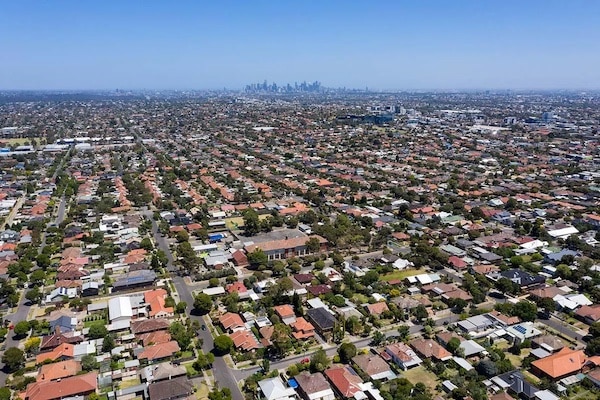In the past few years, whole towns have been wiped out by fire and flood, suburbs have been inundated by floodwaters or storm surges in Sydney and Melbourne, and extreme heat is putting more people in hospitals.
We need an urgent and coordinated response to prepare for heatwaves, rising sea levels and increasingly frequent floods. But governments and property developers won’t listen; they aren’t interested.
Consultancy firm KPMG estimates that 10 million people in Australia live in areas that face “extreme heat-related risks”. And a 2020 study published in The Lancet Planetary Health journal estimated that nearly 37,000 deaths in Australia between 2006 and 2017 were associated with heat.
Yet many homes and workplaces are not designed for extreme weather. While new buildings are required to meet specific energy efficiency standards, the standards are based on average temperatures from 1990 to 2015. Most buildings were constructed before the standards were implemented, so they need to be upgraded to meet higher standards.
There are many ways to improve the temperature regulation of a building. Timber frames, double glazing on windows and proper insulation make a difference. Occupants should be able to move from one side of the building to the other with the sun’s movement and have access to a cross breeze. “Green and blue infrastructure”—such as plants grown on walls and rooftops, sustained with rainwater and recycled water—can also reduce a building’s heat without increasing water usage.
This is a critical issue for society’s most vulnerable, especially the elderly and people with disabilities, who are most affected by heat waves. A 2018 Senate inquiry into the effects of climate change on housing, buildings and infrastructure found that improved housing energy efficiency would have reduced the number of excess deaths during one Melbourne heatwave from 375 to 37.
But most working-class people struggle to pay existing bills. A 2020 Australian Council of Social Service survey also found that more than 60 percent of low-income households struggle to keep their homes cool in summer. That was before the huge spikes in gas and electricity prices over the last two years. Forking out for building upgrades is beyond most people’s means. And renters rely on landlords, who are not known for their generosity. So it can’t be left to individuals.
Air conditioning helps. But energy costs are making it a luxury for a growing number of households. Then there is the issue of power outages during heatwaves, caused by both high demand and the impact of high temperatures on power generation. Governments could help by improving electricity equipment and shifting grids towards renewables and better battery storage.
It is not just buildings that will have to change; cities will, too. There is a glaring need for more urban green spaces. The urban heat island effect is a serious problem. Built-up areas lacking vegetation and containing dark, heat-absorbing materials like asphalt can be 1-7 degrees warmer than surrounding areas.
According to the 2021 report “Temperature Check: Greening Australia’s Warming Cities”, commissioned by the Australian Conservation Foundation, green spaces have declined in every major Australian city except Hobart over the last decade. While Hobart had increased its green space, it did so by only 1 percent. Parks and nature reserves are not viewed favourably in the profit-driven housing industry, which views every centimetre of land as something to profit from.
When constructing new residential areas, developers often clear entire natural habitats before building on them. Even if trees are replanted, they take years to grow into a substantial canopy that creates a cooling effect. To prevent habitat loss, we should focus on building upwards in existing developed areas rather than continuing to expand the city fringes.
Another problem is that developers continue building in areas at risk of flooding and rising sea levels. While it may be satisfying to imagine the coastal mansions of the super-wealthy being destroyed, many regular people will also be affected and won’t have the means to relocate.
We must strategically plan a retreat from coastlines to prepare for future floods and rising sea levels. Building new housing estates in high-risk areas should be prohibited, and more seawalls must be constructed to mitigate the risks. Yet, as one contributor to the Senate inquiry put it:
“If you … need to build a sea wall, you cannot generate a return on a sea wall so there will be zero private sector incentive to build a sea wall. But at the same time, the whole area will benefit from increased resilience to storm surge. So then how do you build an economic model which incentivises investment into public infrastructure, which then creates private sector incentives?”
The straightforward answer is to eliminate the need to consider private sector incentives by ensuring that more public development is carried out for human need rather than profits.
It has been six years since the Senate inquiry. The government finally responded to it on 2 May. To each of the 32 recommendations it gave the same response: “The government notes this recommendation. However, given the passage of time since this report was tabled, a substantive Government response is no longer appropriate”.
Another year, another report. This year we got the results of the “climate risk assessment report”, out of which a “national adaptation plan” is being developed. But after decades of both major parties kicking the can down the road, we should not be holding high hopes for the Albanese government to deliver the sorts of sweeping changes that we need.

